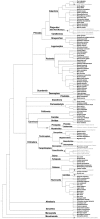Phylogenetic Distribution of CMP-Neu5Ac Hydroxylase (CMAH), the Enzyme Synthetizing the Proinflammatory Human Xenoantigen Neu5Gc
- PMID: 29206915
- PMCID: PMC5767959
- DOI: 10.1093/gbe/evx251
Phylogenetic Distribution of CMP-Neu5Ac Hydroxylase (CMAH), the Enzyme Synthetizing the Proinflammatory Human Xenoantigen Neu5Gc
Abstract
The enzyme CMP-N-acetylneuraminic acid hydroxylase (CMAH) is responsible for the synthesis of N-glycolylneuraminic acid (Neu5Gc), a sialic acid present on the cell surface proteins of most deuterostomes. The CMAH gene is thought to be present in most deuterostomes, but it has been inactivated in a number of lineages, including humans. The inability of humans to synthesize Neu5Gc has had several evolutionary and biomedical implications. Remarkably, Neu5Gc is a xenoantigen for humans, and consumption of Neu5Gc-containing foods, such as red meats, may promote inflammation, arthritis, and cancer. Likewise, xenotransplantation of organs producing Neu5Gc can result in inflammation and organ rejection. Therefore, knowing what animal species contain a functional CMAH gene, and are thus capable of endogenous Neu5Gc synthesis, has potentially far-reaching implications. In addition to humans, other lineages are known, or suspected, to have lost CMAH; however, to date reports of absent and pseudogenic CMAH genes are restricted to a handful of species. Here, we analyze all available genomic data for nondeuterostomes, and 322 deuterostome genomes, to ascertain the phylogenetic distribution of CMAH. Among nondeuterostomes, we found CMAH homologs in two green algae and a few prokaryotes. Within deuterostomes, putatively functional CMAH homologs are present in 184 of the studied genomes, and a total of 31 independent gene losses/pseudogenization events were inferred. Our work produces a list of animals inferred to be free from endogenous Neu5Gc based on the absence of CMAH homologs and are thus potential candidates for human consumption, xenotransplantation research, and model organisms for investigation of human diseases.
Keywords: CMAH; Neu5Gc; pseudogene.
© The Author 2017. Published by Oxford University Press on behalf of the Society for Molecular Biology and Evolution.
Figures




References
-
- Altheide TK, et al. 2006. System-wide genomic and biochemical comparisons of sialic acid biology among primates and rodents: evidence for two modes of rapid evolution. J Biol Chem. 281(35):25689–25702. - PubMed
-
- Altschul SF, Gish W, Miller W, Myers EW, Lipman DJ.. 1990. Basic local alignment search tool. J Mol Biol. 215(3):403–410. - PubMed
-
- Angata T, Varki A.. 2002. Chemical diversity in the sialic acids and related alpha-keto acids: an evolutionary perspective. Chem Rev. 102(2):439–469. - PubMed
-
- Bardor M, Nguyen DH, Diaz S, Varki A.. 2005. Mechanism of uptake and incorporation of the non-human sialic acid N-glycolylneuraminic acid into human cells. J Biol Chem. 280(6):4228–4237. - PubMed
Publication types
MeSH terms
Substances
Grants and funding
LinkOut - more resources
Full Text Sources
Other Literature Sources

